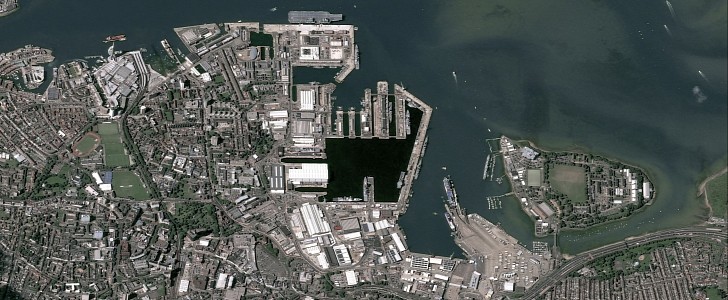Can you spot that aircraft carrier down there, in the photo? Believe it or not, that’s none other than the famous HMS Queen Elizabeth, the Royal Navy’s flagship. That image of it sitting in Portsmouth, UK, was captured a few years ago by the Pleiades satellite, but images of all ships, including “suspicious” ones, are provided by surveillance systems on a regular basis.
Maritime security is particularly important for island nations, like the UK. With 95% of its imports and exports arriving or departing by sea, Britain is more vulnerable to maritime threats. There’s also the increased responsibility of being the only one in charge of ensuring security for its water routes, after having existed the EU. Not to mention climate change, which is another constant challenge, added to other threats.
This is where the Joint Maritime Security Center (JMSC) comes in, a government multi-agency organization that supports the Royal Navy by providing 24/7 monitoring of UK waters. And, in order to do so, it also requires satellite-based surveillance services that would enhance its own intelligence activity. As one of the most reputable sitcom operators in the world, Airbus was the natural choice.
Recently, Airbus’ contract with the Royal Navy, for providing satellite-based maritime surveillance services to the JMSC, was extended for another 12 months, which only confirms how important these services are. This comes after an initial proof of concept phase which turned out to be successful.
By using AIS (Automatic Identification System) data combined with optical and radar imaging, the Airbus satellites can deliver critical information regarding so-called “vessels” and suspicious activity in key areas of interest within the UK Exclusive Economic Zone.
The Vessel Detection Reports can be provided as often as two times per day, for general vessel identification. Also, in case of an emergency, the JMSC can request urgent satellite tasking for monitoring suspicious vessels, wherever they are on the globe.
The contract also includes an alert system that is activated whenever abnormal activity is detected, so that JMSC can quickly address it and, if needed, intercept dangerous vessels.
This is where the Joint Maritime Security Center (JMSC) comes in, a government multi-agency organization that supports the Royal Navy by providing 24/7 monitoring of UK waters. And, in order to do so, it also requires satellite-based surveillance services that would enhance its own intelligence activity. As one of the most reputable sitcom operators in the world, Airbus was the natural choice.
Recently, Airbus’ contract with the Royal Navy, for providing satellite-based maritime surveillance services to the JMSC, was extended for another 12 months, which only confirms how important these services are. This comes after an initial proof of concept phase which turned out to be successful.
By using AIS (Automatic Identification System) data combined with optical and radar imaging, the Airbus satellites can deliver critical information regarding so-called “vessels” and suspicious activity in key areas of interest within the UK Exclusive Economic Zone.
The Vessel Detection Reports can be provided as often as two times per day, for general vessel identification. Also, in case of an emergency, the JMSC can request urgent satellite tasking for monitoring suspicious vessels, wherever they are on the globe.
The contract also includes an alert system that is activated whenever abnormal activity is detected, so that JMSC can quickly address it and, if needed, intercept dangerous vessels.







